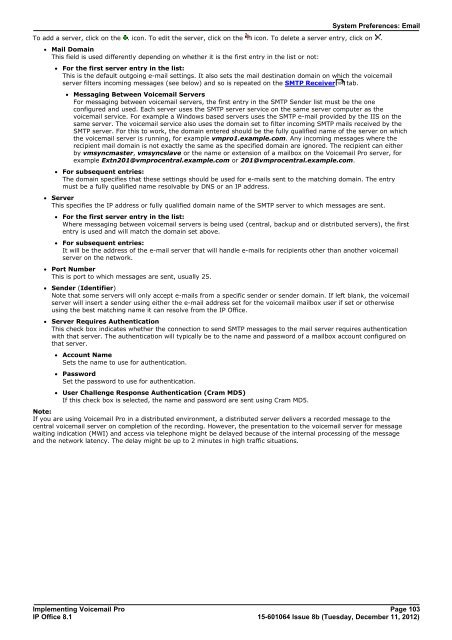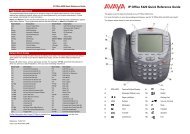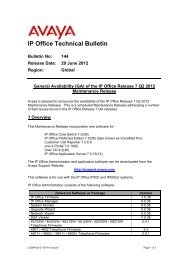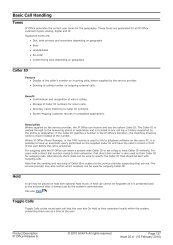Voicemail Pro installation - IP Office Info
Voicemail Pro installation - IP Office Info
Voicemail Pro installation - IP Office Info
You also want an ePaper? Increase the reach of your titles
YUMPU automatically turns print PDFs into web optimized ePapers that Google loves.
System Preferences: Email<br />
To add a server, click on the . icon. To edit the server, click on the icon. To delete a server entry, click on .<br />
· Mail Domain<br />
This field is used differently depending on whether it is the first entry in the list or not:<br />
· For the first server entry in the list:<br />
This is the default outgoing e-mail settings. It also sets the mail destination domain on which the voicemail<br />
server filters incoming messages (see below) and so is repeated on the SMTP Receiver 104<br />
tab.<br />
· Messaging Between <strong>Voicemail</strong> Servers<br />
For messaging between voicemail servers, the first entry in the SMTP Sender list must be the one<br />
configured and used. Each server uses the SMTP server service on the same server computer as the<br />
voicemail service. For example a Windows based servers uses the SMTP e-mail provided by the IIS on the<br />
same server. The voicemail service also uses the domain set to filter incoming SMTP mails received by the<br />
SMTP server. For this to work, the domain entered should be the fully qualified name of the server on which<br />
the voicemail server is running, for example vmpro1.example.com. Any incoming messages where the<br />
recipient mail domain is not exactly the same as the specified domain are ignored. The recipient can either<br />
by vmsyncmaster, vmsyncslave or the name or extension of a mailbox on the <strong>Voicemail</strong> <strong>Pro</strong> server, for<br />
example Extn201@vmprocentral.example.com or 201@vmprocentral.example.com.<br />
· For subsequent entries:<br />
The domain specifies that these settings should be used for e-mails sent to the matching domain. The entry<br />
must be a fully qualified name resolvable by DNS or an <strong>IP</strong> address.<br />
· Server<br />
This specifies the <strong>IP</strong> address or fully qualified domain name of the SMTP server to which messages are sent.<br />
· For the first server entry in the list:<br />
Where messaging between voicemail servers is being used (central, backup and or distributed servers), the first<br />
entry is used and will match the domain set above.<br />
· For subsequent entries:<br />
It will be the address of the e-mail server that will handle e-mails for recipients other than another voicemail<br />
server on the network.<br />
· Port Number<br />
This is port to which messages are sent, usually 25.<br />
· Sender (Identifier)<br />
Note that some servers will only accept e-mails from a specific sender or sender domain. If left blank, the voicemail<br />
server will insert a sender using either the e-mail address set for the voicemail mailbox user if set or otherwise<br />
using the best matching name it can resolve from the <strong>IP</strong> <strong>Office</strong>.<br />
· Server Requires Authentication<br />
This check box indicates whether the connection to send SMTP messages to the mail server requires authentication<br />
with that server. The authentication will typically be to the name and password of a mailbox account configured on<br />
that server.<br />
· Account Name<br />
Sets the name to use for authentication.<br />
· Password<br />
Set the password to use for authentication.<br />
· User Challenge Response Authentication (Cram MD5)<br />
If this check box is selected, the name and password are sent using Cram MD5.<br />
Note:<br />
If you are using <strong>Voicemail</strong> <strong>Pro</strong> in a distributed environment, a distributed server delivers a recorded message to the<br />
central voicemail server on completion of the recording. However, the presentation to the voicemail server for message<br />
waiting indication (MWI) and access via telephone might be delayed because of the internal processing of the message<br />
and the network latency. The delay might be up to 2 minutes in high traffic situations.<br />
Implementing <strong>Voicemail</strong> <strong>Pro</strong> Page 103<br />
<strong>IP</strong> <strong>Office</strong> 8.1<br />
15-601064 Issue 8b (Tuesday, December 11, 2012)






